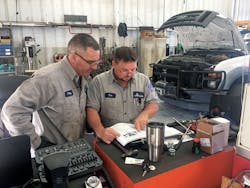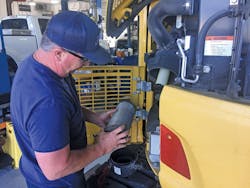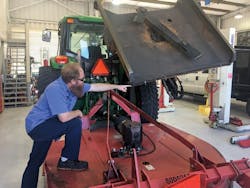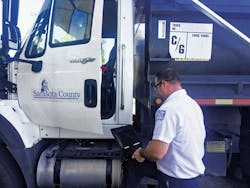Sarasota County Hones in on Technician Training
With 1,700 assets in 200 different classes of vehicles and equipment, Ron Kennedy, CEM, fleet manager for Sarasota County, Florida, has his hands full.
Kennedy knew in 2016 when he took the job after 20 years working for a neighboring county that he wanted to change the way Sarasota managed its equipment and shop personnel, but what area would he dive into first? Training and recruiting? Safety? Preventive maintenance?
He decided on all of them. Growth through training is a consistently high priority.
2019 Fleet Masters
Sarasota County, Florida, is the large-fleet winner of the 2019 Fleet Masters Award, along with small-fleet winner Branch Civil. The awards are presented by Construction Equipment and the Association of Equipment Management Professionals (AEMP) and are judged on categories such as finance, information management, policies, and controls.
“Training is his biggest thing,” says Brianne Hayes, CEM, the county’s operations manager. “He budgets training and education prior to anything else that goes in the budget.”
Sarasota County currently has 23 technicians spread over three ASE Blue Seal-certified shops.
“We spend weeks on training plans,” Kennedy says. “We’ve got a little over a year laid out now for consistent training for just technicians, not including professional development.”
Kennedy says the OEMs the county works with are a key component. “We’ve got a lot of the OEMs involved; GM, Caterpillar, and Deere are all supplying us with training, and our calendars are booked. It’s my goal to keep two technicians at a minimum, at each facility, in training at any one time, year-round. So far, we’re doing it,” he says.
One of the byproducts of training is that it helps the county retain its personnel, especially those technicians. “My firm belief is train them well, and tool them with the latest and greatest out there, to show them I’m willing to invest in them—and pride of ownership seems to go a long way with everybody we have,” he says.
Letting them know they can learn and advance in their careers is another priority.
“I think there’s a pathway, too,” Hayes says. “So we want our techs to grow and train and have the tooling, but also to show them there’s a path to management, a success plan going forward. So we want the newest, greatest technician on the floor to sit in Ron’s seat one day.”
“And I want them to tell me that,” Kennedy says. “What’s your five-year and 10-year plan? I want to hear ‘I want to be sitting in your seat.’”
Kennedy, a Marine Corps veteran, also believes in hiring veterans. One of Sarasota County’s facilities is staffed by over one-third with veterans, and there are more on the way. “We’ve had great luck with hiring veterans,” he says.
“My father was also a Marine,” Kennedy says. “My leadership style, that’s where I learned it—upfront, honest communications. I don’t have a hidden agenda, and I think everybody in our department knows that. I’m here for them; I’m here to take the punch for them.”
Veterans are accustomed to process and structure, Kennedy points out. This plays well with the tasks Fleet Services is trying to accomplish. In fact, Kennedy and Hayes have implemented Six Sigma training to help streamline processes. They have gone through numerous process-mapping exercises on procedures common both in and out of the shop. Think white boards with multiple diagrams and swarms of yellow Post-It Notes. No process is above being questioned.
“Ron’s not afraid to question anything,” Hayes says. “We’re always asking, ‘Why are we doing it this way?’ We routinely reach out to other municipalities and the private sector to find out how they do things.”
The private sector not only includes contractors or fellow AEMP attendees, but it also includes OEMs. “We reach out and ask for their policies and procedures,” Kennedy says. “For instance, on safety glasses. What do they require their team and staff to do? How’s it handled at their dealerships, in their shops? We do that all the time.
“The majority of people are willing to share. They want to tell you,” Kennedy says. “They want to explain things like why their tires are lasting longer.”
Sarasota County technicians are also encouraged to ask questions. “Technicians are empowered to come and ask me why,” Kennedy says. “And that’s what I want. That’s what we all want. If I can’t explain why you’re supposed to be doing something, you probably shouldn’t be doing it.”
Six Sigma-inspired process examinations alone have led to many changes, as has observation.
“The way we’re doing something right now won’t be exactly how we do it three months from now,” Kennedy says. “We’re always evolving. Safety is probably our largest [change]. Daily machine walk-arounds, monthly required training, the stuff that I just thought was [inherent] in a fleet, I didn’t see it when I got here. So we jumped on that, quick.”
Kennedy notes that the head of his fuel program now doubles as safety compliance officer for the entire department, not just Fleet. With a 10- and 30-hour OSHA certification and work in progress toward the 100-hour certification, the officer hosts safety classes once a month that encompass personal and shop safety, focusing on risk avoidance. Also, weekly in-depth safety inspections are conducted and then rolled into a monthly shop inspection that is completed by a separate set of eyes to gain maximum input.
In addition, the compliance officer has marked all shop areas to indicate the requirement for safety glasses, a simple but vital feature that was not present before. Fleet Services has even trained for bloodborne pathogens and an active shooter scenario. “We’ve grown leaps and bounds with the safety program here,” Kennedy says.
Last year, the county implemented a lock out-tag out program. Lock boxes were placed within each shop along with steering wheel locks and covers to be used on any energy-storing assets. Training and implementation programs covered the requirements for day-to-day operations and also procedures to lock out equipment, isolate it from its energy source, and prevent the release of any potential hazardous energy during maintenance services.
“Our safety training, they’re eating it up,” Kennedy says. “I wouldn’t have thought that would have been the case. I thought they’d say ‘Here’s Ron, now he’s going to make us wear steel-toed shoes and put on safety glasses, oh boy.’ On the lock out-tag out, one day the delivery truck showed up with the materials, the next thing I know, they’re everywhere. It’s really neat to see.”
But not everything has been as easy as the safety and training buy-in. The biggest difficulty Kennedy and Hayes have experienced has been with the existing asset-management program. It works somewhat convolutedly at the moment, but progress is being made.
“It was implemented weakly, and I’m not talking about a 7-day period,” Kennedy jokes. “A lot of the pieces were in the wrong places, and now we’re stuck with a furball. The first day I got here, when I couldn’t pull a KPI like I’m used to, I knew we had issues.
“We’ve been working on it since 2016, but when we opened that can up, we thought it would be solved in 6 months or so, and it still isn’t,” Kennedy says. “It affects our billing, our maintenance-management program, and more. If you’re having to physically manipulate data to get what you want and you can’t access it in one place, that’s not good.”
The goal is to access key asset-management information with the click of a button. “We want to be able to do that rather than spending an hour pulling data just for a KPI,” Kennedy says. “Take fuel levels. If I can’t have that information in my pocket during a storm, that’s bad. It’s a matter of cleaning things up and making the system that we already paid for work.”
The crown jewel of Sarasota County’s achievements so far is the overhaul of its preventive maintenance program.
In addition to switching its technicians to real time in order to better track time (and money) spent toward repairs, which is vital information for the county’s overall maintenance rates and overhead, Kennedy initiated a review of OEM standards for scheduling PMs. What he found was surprising. The county was performing maintenance before it had to, before the OEMs’ recommendations.
“We were doing some maintenance way early and doing things on a PM that shouldn’t have been done on a PM, so we fine-tuned it,” Kennedy says.
They applied their findings to all the active maintenance classes in their fleet and experienced a seismic shift into a world of proactivity.
First off, the number of preventive work orders increased and the amount of reactive work orders decreased. And the related dollar figures were spectacular.
The total spent on repairs between the county’s 2017 fiscal year and its 2018 fiscal year was reduced by $823,447, or 22 percent. The number of reactive work orders dropped nearly one-third, down to only 32 percent.
And finally, total technician labor hours on repairs declined a whopping 45 percent.
Sarasota County is now firmly out in front of its maintenance. “We’ve had a drastic reduction in our maintenance costs and saved the county money as a whole because we’re an internal service fund,” Kennedy says.
Kennedy and his team also introduced oil sampling. “We now do scheduled oil samples,” he says. “At every major service, every major component is getting oil sampling. And those findings can also drive the way we’re doing maintenance; for instance, if we find copper or other metals, it can be a clue toward something that needs to be addressed.”
As a leader who’s not afraid to address anything, Kennedy is quick to offer no-nonsense advice for up-and-coming fleet managers; it’s his style. There’s little doubt that some of it likely flows from his military background.
“Keep an eye on your KPIs, they’re your lifeline,” Kennedy says. “You have to be able to sell your business. And, promote your business as much as possible. Reward your employees and make sure they know you respect them. Stress training, always. That’s the line we fund first.
“Set the bar high, but attainable. Then—if you think you’re at the best—raise it another notch.”



